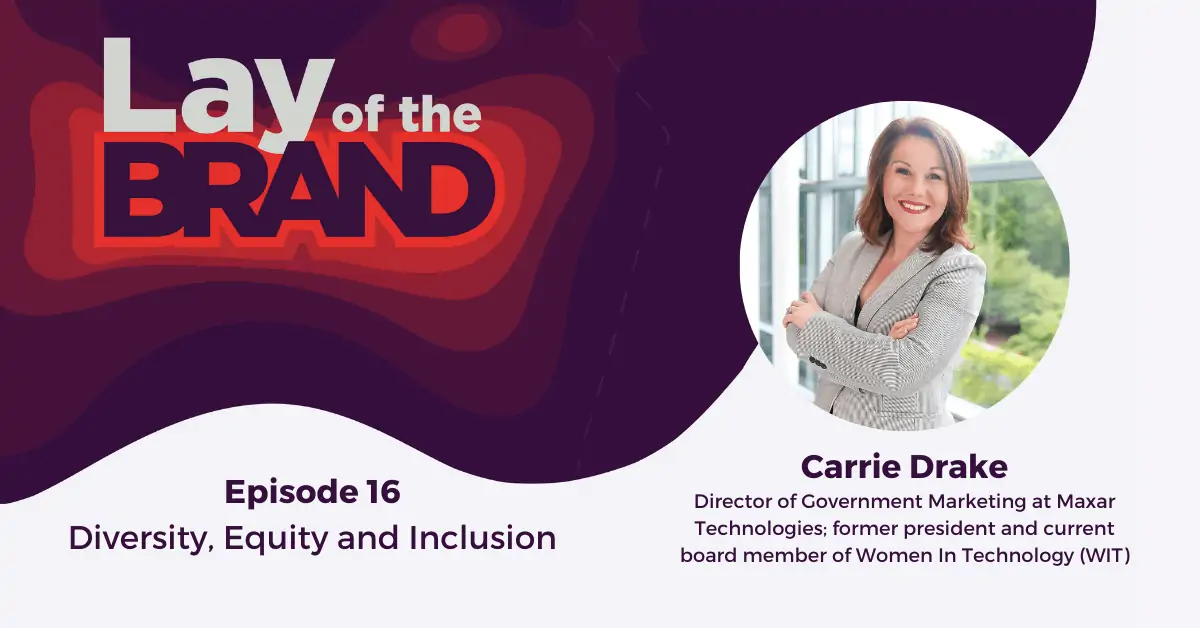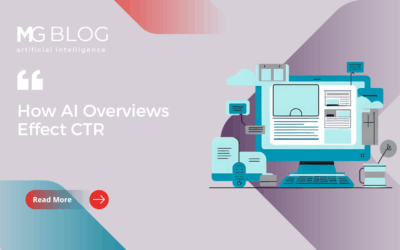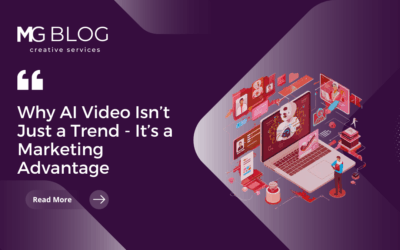“It comes back to diversity of thought, are you shaping your message for various audiences or are you shaping your message for one?”
— Carrie Drake, Director of Government Marketing, Maxar
Diversity, equity, and inclusion (DE&I) are in the forefront of a national conversation from public policy to how businesses operate. B2B and B2G tech firms are examining how they can or should incorporate these values into every aspect of their operations. For marketers and PR pros, it’s a question that drives decisions about messaging, outreach, and whether or not to take a public stand on issues.
We look at ways companies can navigate these waters in our latest Lay of the Brand podcast with Carrie Drake, Director of Government Marketing for Maxar and the former president and a current board member of Women in Technology.
Here are highlights of our conversation. Click below to listen to the podcast or visit layofthebrand.com.
Diversity and Tech Opportunities
Peter Jacobs, Lay of the Brand: Carrie, you’re the former president of Women in Technology and a staunch advocate for workplace diversity. So how has diversity, equity, and inclusion impacted your marketing career?
Carrie Drake, Director of Government Marketing for Maxar: First of all, I think I’ve been very fortunate. I don’t feel that I have truly experienced inequity in my career, at least not in obvious ways.
One of the things that I’m incredibly passionate about is using my opportunity and my privilege to make sure that other people don’t experience inequity in diversity in their careers.
So for me, for marketing and my career trajectory, I’ve been fortunate. I’ve had a number of leaders, managers, and mentors who have made sure to bring me along. Folks that are also cognizant of inequity in the workplace and in different areas of business, who want to make sure that they are acknowledging women, people of color, and people with disabilities, all areas where folks may be discriminated against. I’ve been fortunate to have mentors that have done that for me, it’s been wonderful to work for some great organizations and leaders that have made sure to elevate me along the way.
Peter Jacobs, Lay of the Brand: A recent Forrester study said about 25% of B2B tech company CEOs are minorities, which is much higher than the average of 10% across all sectors, and close to the overall minority population in the tech industry. Has the growth of DE&I at tech organizations changed marketing and PR?
Carrie Drake, Director of Government Marketing for Maxar: I think our country is experiencing a moment right now where this subject matter is at forefront. So I wouldn’t necessarily pin it to just the growth of DE&I in tech organizations, I would pin it to the fact that this is at the top of everyone’s mind. So it is impacting marketing and PR because we do need to be cognizant of the current events that are taking place, of how our brands show up in the market space, whether that’s in technology or any industry.
Being aware of what’s happening around you and making sure that you have the right voice in the conversation is what’s really driving the impact of diversity and equity and inclusion in marketing and PR.
The Marketing + PR Landscape
Peter Jacobs, Lay of the Brand: So, within corporations, because they’re all trying to figure out how to deal with it in different ways, is DE&I affecting the makeup of marketing and PR organizations?
Carrie Drake, Director of Government Marketing for Maxar: I think the DE&I is affecting the makeup of all organizations, so yes. One thing I like to focus on is that you can’t have diversity in your message or innovation or creativity if you don’t have diversity of thought, diversity of opinion, and that requires representation of all kinds. If you are only marketing towards one group or only listening to one group, you’re not going to have a number of perspectives that you’re able to incorporate into how your brand shows up. I think we do a lot of work in marketing and communications like customer listening, what the numbers tell us, and how our message is reaching different groups. Demographics have always been a key to how we are successful with marketing and public relations. It drives our decision-making in this industry, so with efforts behind diversity and equity and inclusion, those numbers are even more impactful. It does impact the makeup of marketing and PR, but I think if you’re doing it right, it should always have been right.
Peter Jacobs, Lay of the Brand: The marketing and PR and communications organizations are the guardians of the brand, those roles are supposed to make sure that the brand stands for something, something recognizable and something that appeals to the audience that you’re targeting. Of course it doesn’t mean just including pictures of people, of different races or genders in your advertising. What are some of the things that you can do as part of a marketing organization to start truly incorporating diversity into your marketing content and your PR outreach?
Carrie Drake, Director of Government Marketing for Maxar: I think from a visual aspect, it is very important to make sure that you have a wide range of who you are depicting in visuals, but it does go way beyond pictures. How are you reaching an audience through the language? Are you making things accessible for disabilities? One of my favorite phrases to use with teams, that I actually learned from a colleague when I was first starting out in marketing and communications, is, especially when it comes to branding, that “you meet people where they are, to take them where you want them to go.”
What do you understand about the people that you’re trying to reach? How are they receiving information? What are they interested in? How can you make sure that you are meeting them there and teaching them the things you want them to know about your brand, product, service, industry, or cause? That helps them grasp it in a way that they like to receive information or that speaks to them about something they’re passionate about.
I think really listening to the customers and being able to incorporate different types of language and platforms — different groups and demographics receive information on different platforms. There’s a number of things we could dive into there. It comes back to diversity of thought, are you shaping your message for various audiences or are you shaping your message for one?
Carefully Managing Recruitment and Diversity
Peter Jacobs, Lay of the Brand: Pivoting off that, back to something you said earlier about corporations needing to become more aware and more forthcoming about their DE&I initiatives — what about the makeup of marketing and PR organizations themselves? Don’t you need diversity on the teams in order to have diversity in your marketing?
Carrie Drake, Director of Government Marketing for Maxar: We need diversity on all teams. It’s so important, especially with younger age groups. As corporations are presenting their leadership, it’s important for people to see people like them in roles, to understand that they too can do this. If you grow up and you never see a female leader, a female leader of color, a leader that may be disabled in some capacity, you don’t think of yourself in that role. You can model behaviors by making sure that you are providing the right kind of representation and showing that you are accepting and inclusive.
The flip side of that is you want the best people, no matter who they are. So are we providing the opportunities to build a team that includes the best people, no matter what?
Are you attracting the right people to your team because you have that diversity already showcased? Is it intimidating when you’re building a team? If you’re walking into an all white male organization, and you’re the only person of color or the only female, it can be harder. It can be a little more challenging and a little less inviting to other people. So it’s incredibly important to build diverse organizations and teams, to have diverse opinions and input, and to understand how people are able to access information.
Think about different socioeconomic statuses, you may be the type of company that tries to attract the best talent from Ivy League universities, but if you’re only showcasing Ivy League graduates, you may be missing some really incredible talent from other universities, people that have been innovative in their own right and had a different path to success and education. So bringing in different demographics to make a diverse team is how you can have a really holistic message and approach to your business.
DE&I + Accessibility
Peter Jacobs, Lay of the Brand: DE&I is frequently used to mean race and gender equality, but there’s a lot of other aspects to it. Inclusion of people with disabilities has to be considered as well. What can marketers do to influence greater tech access and inclusion?
Carrie Drake, Director of Government Marketing for Maxar: We live in an age where technology is at our fingertips at all times, there’s a lot of people that think about it often. We’re going to market and we need to hit every social media platform, we need this display ad, and we need to have a robust website, but are you thinking about people that are using screen readers for their website? Is your website accessible to folks with visual impairments? You’ve got a number of pieces of video content on your website, have you made sure that they have closed captions? When you’re recruiting for the rest of your company, people are going to your website. If you’re not meeting these accessibility guidelines, you’re missing out on great opportunities.
When you’re researching a company or a product or you’re shopping, the first thing you want to do is have an easy user interface and experience on your website. For example, when you’re struggling to find a sign up for registering your kid for flag football — I just experienced this. I was like, this is the hardest website to manage, and I don’t have any challenges. I’ve got access to a strong iPhone where I can pull up a website on my phone. If people are using their phones primarily because they don’t have computers, if your website isn’t working or optimized for your phone, then you’re missing customers. You’re missing good opportunities if people can’t find what they want to do.
Like I said, I had great access and I couldn’t find the link to sign my kid up and I almost gave up on it. Can you imagine if you’re going to a website and you’re using a screen reader, and it’s not able to tell you what you’re saying, you’re going to miss that opportunity. For example, if you’ve created this beautiful marketing video that really showcases your product or service, and it’s got amazing music, really awesome graphics, and great voiceover, somebody that is hearing impaired can’t hear your message if you don’t put any closed captioning on your video. You’ve missed that customer.
It’s very important to make sure that you’re not just hitting the pretty pictures and the strong words, you need to ensure people are able to access your information.
It’s not just your social media content, it’s not just your website. All of these things need to integrate and make sure that they’re inclusive, not just of gender or religion or racial demographics, but also all kinds of accessibility elements.
Breaking Down Silos To Craft Influential Stories
Peter Jacobs, Lay of the Brand: At a lot of companies, marketing also gets involved in internal communications and internal branding activities. Marketing organizations should work with their internal counterparts in HR and operations and product development, because that’s how you have a more cohesive organization, but specifically to advance DE&I. What strategies can marketers use to help other teams integrate those concepts into their practices?
Carrie Drake, Director of Government Marketing for Maxar: I personally believe that one of the strongest ways to build your brand both internally and externally is a focus on the people that make up your company. Their passions for whatever mission that either your company or organization is supporting or a passion for the mission of your customers and showcasing the talents of individuals. There’s some great opportunities to do that both internally and externally. That helps you achieve a lot of things because you want to inspire other team members.
It goes back to what I was saying about seeing people like themselves in the story. It humanizes the workforce, if you will. It gives you an opportunity to understand people, especially in larger companies, understand who makes up your team, and by team I mean your whole organization — the different aspects of the business, the different talents it takes to build your technology, the different talents it takes to engage with the customer, and the different life experiences that team members have had.
I really believe that finding ways to showcase teammates both internally and then externally for your brand as well, is a great way to encourage and showcase diversity and inclusion for an organization. People like to be asked about the things that they do and they like to feel valued.
So finding a way to share the stories of other people is a great way that marketing and communications teams can help with the diversity and inclusion efforts.
Adapting Brand Communications to Reach Younger Generations
Peter Jacobs, Lay of the Brand: Another aspect of DE&I that doesn’t get talked about a lot, but ought to, is age. Millennials make up more than half of the global workforce. Nearly half of B2B millennial buyers are the primary decision maker at their company. Even Deloitte’s Global Millennial Survey found that values and morals are the top factors influencing millennials’ business decisions. How can B2B tech marketers and PR professionals adapt to meet the expectations of younger generations?
Carrie Drake, Director of Government Marketing for Maxar: I think different generations have so much technology and information at our fingertips. We are finding ways to communicate and finding generations are feeling empowered or confident in hiding behind their devices — sometimes it’s not hiding behind their devices, sometimes they’re feeling that they have a platform, they can make their voice heard.
Everybody can be a marketer in some way or another with some of these social media platforms. So I think as marketing professionals, we need to understand what various generations are passionate about. We talk about using the platforms to market our business, but also how folks are engaging in what’s trending and making sure that you are speaking to those groups.
It’s not necessarily engaging in some of the more controversial subject matter. Where are people picking up their messages? Are you using your pull to educate about a cause or an organization? Are you targeting each demographic in the way that they might want to be targeted? We’ve learned about some of the younger generations and sometimes they get a lot of flack for it, but I think there’s some real positive elements to the fact that they want to work for a mission that they’re passionate about. They want to feel like they’re making an impact. A lot of technology platforms are enabling more and more people to see where they can make an impact. They’re seeing more from regular people — not just celebrities, not just brand ambassadors that are being paid.
People get to use these platforms to have an opinion and share their opinion and pick up other people’s opinions and pick up information. Are you using your platform in a way that provides them with the information that they want to receive, and that is feeding into that desire to make an impact and provide their talent and efforts across a mission that they feel passionate about? You can break down different social platforms or different marketing platforms and see that generations use different platforms differently. There’s always some new app or platform that younger groups are picking up and changing the way that they’re communicating. I think right now we’re even seeing kids interacting through some of these gaming platforms.
As marketing and PR professionals, we have an opportunity to use our platforms for good, to push out information that educates and supports fact-finding, and provide tools for success and opportunities to reach other groups and connect people.
We should, and we certainly can, influence through our brands and these platforms.
Wrapping Up: DE&I and the Future of Marketing + PR
Peter Jacobs, Lay of the Brand: What advice do you have for marketing and PR professionals for addressing DE&I?
Carrie Drake, Director of Government Marketing for Maxar: I’m going to take this back to diversity of thought. It’s so easy to curate an echo chamber. Making sure that you are seeking information of different demographics than yours. Making sure that when you’re looking across your team, you’re building a diverse team in all ways, shapes, and forms. You’re researching and reaching out and asking the right questions. Learn what you can about the data and what the data will tell you, because that will help you drive your messaging, goals, and objectives in the direction where you want to improve that data.
There’s a huge stream of data from all different kinds of sources and sensors. Sometimes it can be too much, but really learning to understand what that data tells you about how your message is working, the people that you’re reaching, and where you have gaps, can really help in building a more diverse team, brand, and message. We can certainly look to support a number of missions by growing through diversity, both with providing a number of voices, but also understanding what the numbers tell us.
Want to learn more about how to address diversity, equity, and inclusion within your company? and listen to this podcast and other episodes at layofthebrand.com or your favorite streaming platform.
Want to boost your B2B marketing? Listen to this podcast and other episodes at layofthebrand.com or your favorite platform including Google Play, Apple Podcasts, Spotify, Stitcher and YouTube.




